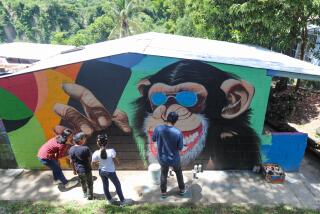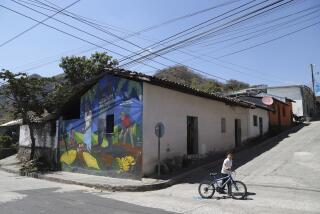At museum, Nicaragua president’s favorite masterpiece is himself
Reporting from Managua, Nicaragua — Go to the Museum of the Sandinista Victory, and Nicaraguan President Daniel Ortega is everywhere. There he is on the northern front of the revolutionary war — and the southern front, and the western front.
Ortega has Forrest Gumped himself onto all the major battle lines of the struggle that dethroned dictator Anastasio Somoza in 1979, carried the Sandinista movement to power and radically changed Nicaraguan history.
As for all the other comandantes and major figures who shared in those events with similar or even more important roles?
“We have been erased,” said Sergio Ramirez, the renowned writer and a member of the Sandinista government who served as vice president during Ortega’s first term as president, from 1985 to 1990.
Ortega lost in 1990 — the first post-revolution democratic election — and lost three more times before finally returning to power by winning the presidential election in 2006.
The museum, a government-run project about a year old, is an open-air display that purports to illustrate the historic fight of the Nicaraguan people to rid their nation of decades of “gringo invasions” and other onerous shackles (as the young tour guide put it).
It is also but one example more of what many here see as the cult of personality surrounding Ortega.
In the age-old tradition of dictators including Kim Jong Il and Saddam Hussein (not to mention Somoza, whom Ortega did help depose), the Nicaraguan president has built a national homage to himself. Billboards dot this sprawling, haphazard capital with a larger-than-life picture of him alongside national heroes Ruben Dario and Augusto Sandino. Nicaraguans speak less of Sandinismo and more of Danielismo.
“You invest enough in a myth, and you begin to believe it is true,” Ramirez said of Ortega, with whom he had a falling-out years ago.
Dora Maria Tellez, another leader in the Sandinista revolution, who famously helped command a guerrilla takeover of the National Palace in 1978, where Congress was in session, scolded Ortega and his supporters for minimizing the many fighters who lost their lives. She too was left out of the museum.
“Soon, Ortega will be the only leader of his faction, the only combatant, the only revolutionary, the only governor, the only liberator — the one indispensible,” she told El Nuevo Diario shortly after the museum opened last year.
Critics accuse Ortega of sidelining what was a collective movement, the Sandinista Front, to replace it with glorification of his own role and current virtual omnipresence.
This comes as Ortega is attempting to rewrite the Nicaraguan Constitution so he can succeed himself in the presidency and, many suspect, hang on to an enriching and increasingly autocratic power indefinitely. It is part of a trend across Latin America, where several elected presidents, mostly on the left but also the right, have attempted to use democratic institutions to essentially undermine democracy and cement their position in office.
Ortega’s actions horrify many in Nicaragua, especially his erstwhile allies and compañeros. But most of the population hadn’t been born during the pivotal events in the Sandinista revolution. Many youths have been drawn to today’s incarnation of a populist leader who incongruously portrays himself as a revolutionary and born-again Christian.
Ortega does not generally speak to the international press but has defended his presidency as one that works on behalf of the poor. Nicaragua remains the second most impoverished country in the hemisphere.
In last month’s celebration of the 31st anniversary of the revolution, Ortega filled a plaza with supporters chanting his name — “Daniel! Daniel!” — and told them that the Nicaraguan people “deserve” his continued leadership.
wilkinson@latimes.com
More to Read
Sign up for Essential California
The most important California stories and recommendations in your inbox every morning.
You may occasionally receive promotional content from the Los Angeles Times.










